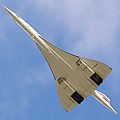Strake
Strakes are aerodynamic assemblies on aircraft that influence the flow over the wings at high angles of attack in combination with high speed. They consist of an extension of the leading edge of the wing at the transition between the wing and the fuselage. Strakes are also called LERX as an acronym for the descriptive term L eading E dge R oot E X tension .
Mode of action
On wings with a small extension , e.g. B. Delta wing and trapezoidal wing on fighter planes, the flow separates with increasing angle of attack at the leading edge and forms a stable leading edge vortex (LEV = Leading Edge Vortex) over / along the wing. This creates strong negative pressures on the upper side of the wing and thus increases the lift. This leads to what is known as non-linear lift.
At high angles of attack , the leading edge vortex does not lie completely on the leading edge, but rather "bends" over the wing following the main flow. So-called backflow zones are created above the outer wing. The positive effect of the vortex then only acts on the inside of the wing, while the flow collapses on the outside. This reduces lift and steering effect.
Strakes are supposed to prevent this collapse of the outer flow and stabilize the vortex system above the wing. On the fuselage side, the leading edge of the main wing is strongly swept forward. This extension is the strake (LERX). In the case of a flow with a positive angle of attack, a vortex is released both on the strake and on the leading edge of the main wing. The strake vortex displaces the “turning” main vortex outwards and stabilizes it over the outer wing. In this way, larger areas of the wing can be used to generate lift and the flow of air to the control surfaces remains more effective.
More options
In addition to strakes, there are other possibilities to control the flow above the wing, v. a. above the outside area, to stabilize:
- Boundary layer fence
- Saw tooth (aerodynamics)
- Vortex generator
- Sucking off / blowing out the boundary layer
- Canard wing
Examples
- Various aircraft with strakes in the aerodynamic design
F / A-18C with a pronounced strake running forward on the torso.
F-16 with visible vortex generation on "small" strakes between cockpit and leading edge of the wing.
Space shuttle with strakes that extend forward to the cockpit.
The wings of the Concorde flow smoothly into strakes in the front area.





